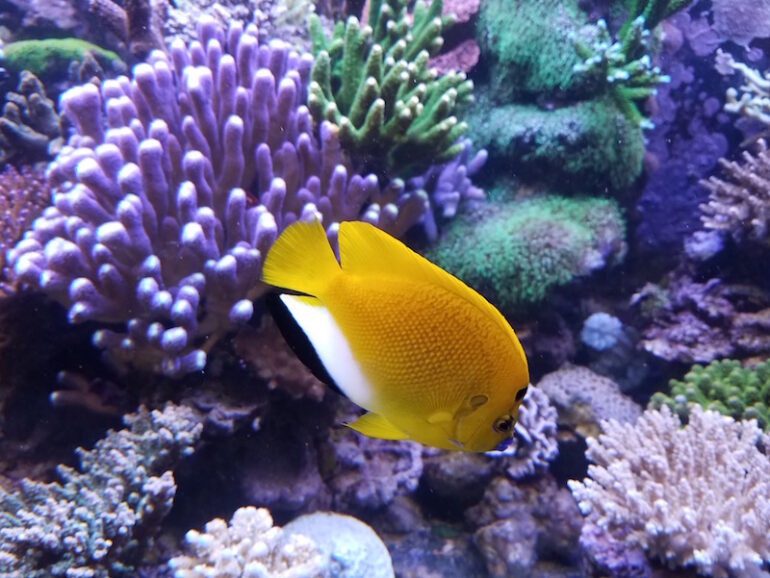
Last week, we ran a post titled “How Do We Measure Success with Hard-to-Keep Marine Species,” which inspired Paul “Seasoned Salty” Baldassano to share his insights on that question in his own, unique style. Read on for his impressions on the topic. – Editor
With some hobbies, such as stamp or coin collecting, writing poetry, painting, model building, etc., it is not easy to tell whether you are successful, as those hobbies are subjective. As long as you like what you are doing, you are successful at it. Marine fishkeeping is different, and it is relatively easy to tell whether you are successful or not—the fish in your care either survive and thrive or they don’t.
Fish are different by design
Keeping cold-blooded fish and invertebrates is not the same as keeping a dog or cat. Dogs and cats can live a very long time, even if they have some sort of malady or disease, but most aquatic creatures can’t. It has to do with their immune system, which has to work better than a land animal’s does because the liquid a fish is living in is actually an extension of its circulatory system and everything that is in the water is in the fish.
A fish’s immune system is directly regulated by how well that fish eats, whereas we can sit in front of a TV for decades, eating chips and drinking beer, and our immune system will still protect us. Sure, we will probably die from a heart attack, damaged liver, or our spouse hitting us over the head with a rolling pin, but our immune system will still function. Fish are not designed like that, which is the reason so many hobbyists have problems with ich and other maladies. Fish in the sea, eating their normal diet of live fish, fresh seaweed, and plankton, are practically immune to those things.
Signs of senescence

It is usually easy to tell if a fish is dying of old age, even though we sometimes don’t know how old a fish is when we buy it. Of course if it is a small specimen, it is probably a year or so old, as fish grow fast.
I’ve had many fish die of old age (oddly enough, I have a striped cardinal that is dying of old age right now), and they all exhibited the same symptoms. They show no signs of disease and may hang out in a corner, disinterested in doing anything like looking for food or chasing away a favorite enemy. In a few days, they start to have deteriorating fins, and other fish will begin to nip at them. In the last stages, they lie on the bottom, breathing normally and just wasting away. When you think about it, we also die in a similar fashion (with the exception of our friends and family members nipping at us, hopefully).
How long is long enough?
If we keep a fish, such as a tang, alive for five years, we may think that is great. But that’s like a human living for only 15 years. If there were a town where all the inhabitants died as teenagers, you would probably not want to live there, as you’d rightfully assume something is very wrong there. That is the way a lot of tanks function, so we can’t really call those tanks successful. But if all your fish live long enough to die of old age, then you’re on the right track.
So, we need to know the normal lifespan of a fish to determine whether it is living long enough in our care. Many small cardinalfishes live for only around four to five years, so if you had a small cardinal and it lived that long, you can call that a success. On the other hand, if you have a clownfish and it lives only five—or even ten—years, that is not a success, as clownfishes commonly live over 20 years. In fact, I have a 20-year-old fire clownfish, and it is still spawning.
Spawning is a good sign!
Speaking of spawning, that’s another indicator of fishkeeping success because only the healthiest fish will spawn. Spawning is a huge burden for a fish, as the eggs may be a third of the weight of the mother fish and those eggs are composed mostly of oil. So the fish not only has to take in enough food to live and stay healthy, but also to produce all those eggs—and healthy fish spawn routinely.

I have a pair of clown gobies that spawn about every week and a half and have been doing so for over a year. I also have a pair of mandarins that spawn about once a month. That is a success, as healthy fish spawn all the time.
Egg scatterers, such as angels and tangs, will not usually spawn in a home aquarium as they need much more water to feel secure enough to spawn, but all damsels, including clownfish, will and should spawn in a tank. All gobies, cardinals, mandarins, seahorses, and pipefish will spawn in a tank, as well. If you have a pair of such fish and they are not spawning, there is something wrong and they are not as healthy as they should be.
Photo Credit: Paul Baldassano



